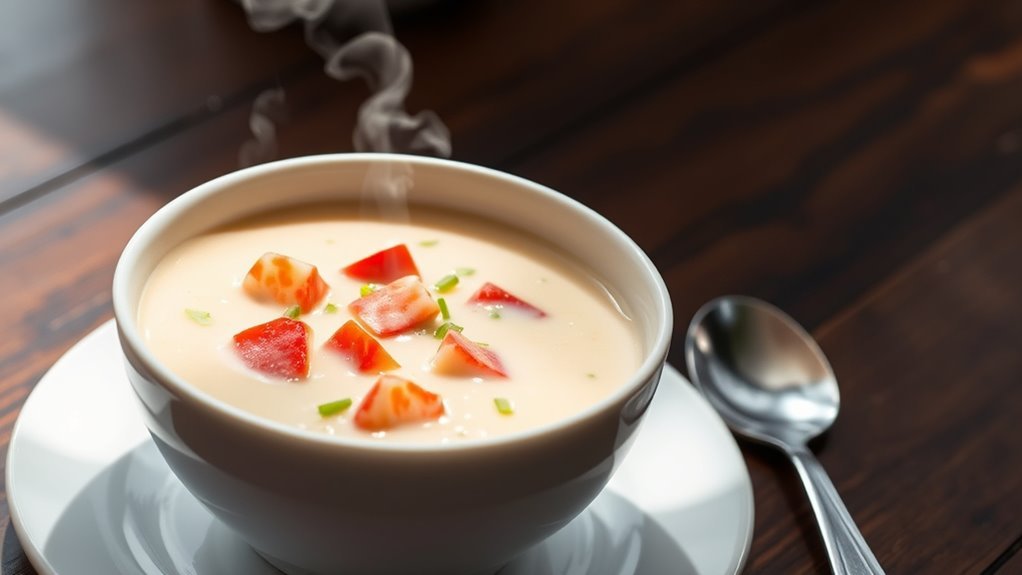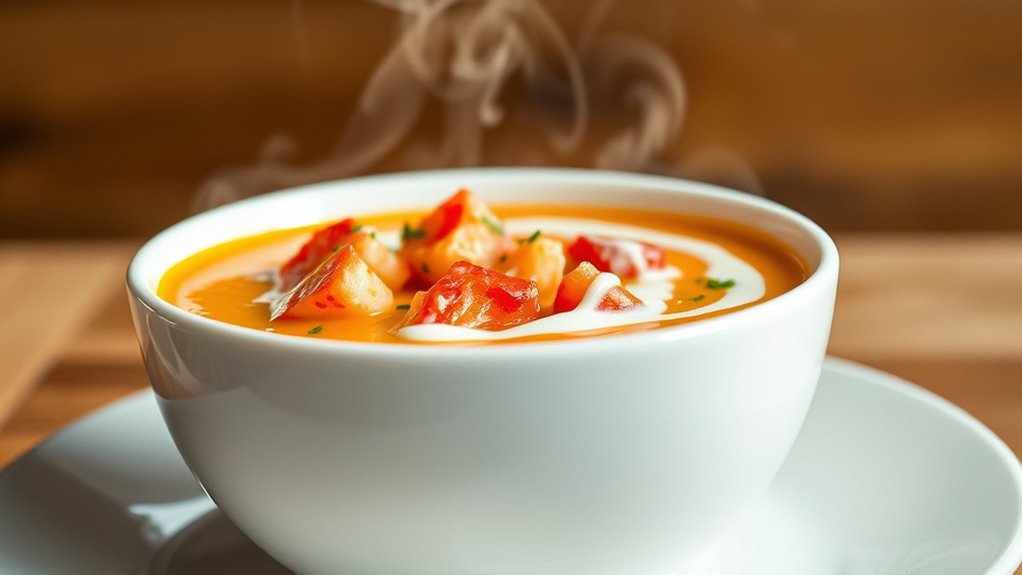Lobster bisque can be keto-friendly if you make mindful ingredient choices, focusing on high-fat components and low carbohydrates. Traditional recipes may include flour or higher-carb veggies, but you can modify them by using cauliflower or zucchini as a base. Opting for heavy cream or cream cheese boosts the richness without adding carbs. Portion control is key, so consider serving smaller amounts. There’s more to explore about making this dish fit into your diet, so keep going!
Understanding Lobster Bisque Ingredients

Lobster bisque is a luxurious seafood soup that typically combines rich flavors and creamy textures, making it a popular dish in fine dining. The key ingredients often include various lobster varieties, such as Maine or spiny lobster, which contribute to its distinct taste. In bisque preparation, you’ll find a blend of aromatic vegetables, like onions and celery, alongside a base of seafood stock and cream. This combination creates that velvety mouthfeel you love. Some chefs also incorporate brandy or sherry for added depth. Understanding these ingredients helps you appreciate the balance between the sweet, delicate lobster meat and the savory broth. With this knowledge, you can explore variations that suit your palate while enjoying this exquisite dish.
Analyzing Nutritional Content

While enjoying a bowl of lobster bisque may seem indulgent, it’s vital to analyze its nutritional content, especially if you’re following a keto diet. Understanding the calorie breakdown and nutrient density can help you make informed choices. Here’s what to take into account:
Analyzing lobster bisque’s nutritional content is crucial for those on a keto diet to make informed dining choices.
- Calories: A typical serving can range from 300 to 500 calories.
- Fats: Rich in healthy fats, which aligns well with keto principles.
- Protein: Offers a good protein source, mainly from lobster.
Balancing these factors is essential. While the bisque is high in fat and protein, be mindful of portions to maintain your keto goals. By analyzing the nutritional content, you can enjoy this luxurious dish without straying from your dietary path.
Carb Considerations for Keto

When considering a keto diet, it’s important to pay attention to the carb content of any dish, including lobster bisque. Traditional lobster bisque can contain various carb sources, primarily from ingredients like flour, cream, and vegetables. These components can greatly impact your daily carb allowance, which is typically limited to about 20-50 grams according to keto guidelines. Keeping track of these carbs is vital for maintaining ketosis, the metabolic state that promotes fat burning. By understanding the carb content in lobster bisque, you can make informed choices that align with your dietary goals. Remember, it’s all about balance and being aware of what you consume while enjoying the flavors of your favorite dishes.
Modifying Lobster Bisque for Keto
To enjoy lobster bisque on a keto diet, you’ll need to make some thoughtful modifications to the traditional recipe. Here are a few tips to help you stay on track:
- Lobster substitutions: Instead of using high-carb ingredients like flour, consider using cauliflower or zucchini as a base for your bisque.
- Thickening agents: Opt for keto-friendly options like cream cheese or heavy cream to achieve that rich, creamy texture without the carbs.
- Flavor enhancement: Add in fresh herbs and spices like dill or paprika for depth, without adding any carbs.
With these modifications, you can savor the delicious flavors of lobster bisque while keeping your keto goals intact. Enjoy your culinary freedom and indulge in a comforting bowl of bisque that fits your dietary needs!
Alternative Keto-Friendly Seafood Soups
If you’re looking for keto-friendly seafood soups, creamy clam chowder and shrimp avocado soup are excellent options to contemplate. Both recipes can be easily adapted to fit a low-carb diet without sacrificing flavor or texture. Let’s explore how to make these delicious soups while keeping your keto goals in mind.
Creamy Clam Chowder Recipe
Although many traditional clam chowder recipes are rich in carbohydrates due to potatoes and flour, you can easily adapt this classic dish into a keto-friendly version without sacrificing flavor. By using low-carb ingredients, you’ll enjoy a delicious seafood soup that aligns with your dietary goals.
Here’s a quick overview of how to make your creamy clam chowder keto-friendly:
- Replace potatoes with cauliflower for a low-carb base.
- Thicken the soup with heavy cream or cream cheese instead of flour.
- Add spices like thyme and pepper for enhanced flavor without carbs.
Embracing clam chowder variations like this not only satisfies your palate but also allows you to reap the seafood soup benefits, such as high protein and omega-3 fatty acids. Enjoy your guilt-free chowder!
Shrimp Avocado Soup Ideas
Looking for a revitalizing twist on your seafood soups? Shrimp avocado soup might just be the perfect keto-friendly option. This dish combines succulent shrimp, packed with protein and low in carbs, with creamy avocado, which offers numerous health benefits such as healthy fats and fiber.
To make your soup, sauté shrimp with garlic and onion, then blend in ripe avocados, vegetable broth, and a squeeze of lime for a invigorating kick.
Not only does this recipe highlight the versatility of shrimp recipes, but it also guarantees you’re reaping the avocado benefits. You’ll enjoy a delicious meal that aligns with your keto lifestyle, keeping your taste buds happy and your dietary goals intact. So, give it a try!
Enjoying Lobster Bisque in Moderation
When enjoying lobster bisque, it’s important to contemplate its nutritional content, particularly its carbohydrate and calorie levels. You can practice portion control by opting for smaller servings, which allows you to savor the dish without overindulging. Additionally, exploring low-carb alternatives can help you enjoy similar flavors while staying aligned with your dietary goals.
Nutritional Content Overview
While enjoying lobster bisque can be a delightful culinary experience, it’s essential to take into account its nutritional content, especially if you’re following a ketogenic diet. This rich soup typically has a high calorie breakdown due to cream and butter, but it also offers some nutrient density from its lobster base.
Here are a few key points to keep in mind:
- Calories: A standard serving can contain around 300-400 calories, depending on the recipe.
- Carbohydrates: It often has some carbs, mainly from any added vegetables or thickeners.
- Fats: Lobster bisque is usually high in healthy fats, aligning well with keto principles.
Enjoying it in moderation can let you savor the flavors while staying mindful of your dietary goals.
Portion Control Strategies
To enjoy lobster bisque without straying from your dietary goals, implementing portion control strategies is essential. Start by being aware of serving sizes; a standard portion is typically around one cup. This can help you enjoy the rich flavors while keeping your carb intake in check. Practicing mindful eating can also enhance your experience. Slow down and savor each bite, which encourages satisfaction with smaller amounts. If dining out, consider sharing a bowl with a friend or asking for a smaller portion. These strategies allow you to indulge in lobster bisque while maintaining your keto lifestyle. Remember, moderation is key, and being mindful of your choices empowers you to enjoy delicious foods without compromising your health goals.
Low-Carb Alternatives
If you’re looking to enjoy lobster bisque while keeping your carb count low, there are several alternatives that can help you stay on track. By incorporating low-carb substitutions and keto friendly ingredients, you can savor this delicious dish without derailing your diet. Here are a few options:
- Cauliflower puree: Use this creamy alternative instead of traditional flour-thickened bases for a velvety texture.
- Coconut milk: This dairy-free option adds richness while being low in carbs.
- Shirataki noodles: If you want a noodle-like texture, these miracle noodles are low in carbs and calories.
Frequently Asked Questions
Can I Freeze Leftover Lobster Bisque?
Yes, you can freeze leftover lobster bisque! To guarantee the best quality, let it cool completely before transferring it to airtight containers or freezer bags. You might want to leave some space at the top for expansion. When you’re ready to enjoy it again, thaw it in the fridge overnight and reheat gently on the stove. These freezing tips will help maintain the flavor and texture during bisque storage, giving you a tasty treat later!
How Long Does Homemade Lobster Bisque Last in the Fridge?
Homemade lobster bisque lasts about 3 to 4 days in the fridge when stored properly. To maintain bisque freshness, make sure to store it in an airtight container. If you notice any off smells or changes in texture, it’s best to toss it out. For longer storage, consider freezing it instead. Always prioritize your health and safety by checking the bisque before consuming, ensuring you enjoy every delicious spoonful!
Is It Safe to Reheat Lobster Bisque Multiple Times?
It’s generally not safe to reheat lobster bisque multiple times. Each time you heat it, you risk bacterial growth, especially if it’s not stored properly. Ideally, you should only reheat the portion you plan to eat. Lobster bisque storage in the fridge is safe for about 3-4 days. For best quality and safety, consider reheating only once and make sure it reaches a safe temperature before consuming.
What Type of Wine Pairs Well With Lobster Bisque?
When you savor lobster bisque, think of a sunlit afternoon by the shore, where fresh ocean breezes kiss your skin. A crisp white wine, like Sauvignon Blanc or a buttery Chardonnay, enhances the bisque’s rich flavors beautifully. Pairing suggestions include a dry Riesling for a hint of sweetness or a Pinot Grigio for its invigorating acidity. Each sip should feel like a liberating moment, elevating your dining experience to new heights.
Can I Use Canned Lobster for Bisque?
Yes, you can use canned lobster for bisque preparation. While fresh lobster offers superior flavor and texture, canned lobster can still provide a convenient and tasty alternative. Just make sure to drain it well and consider adding fresh herbs or spices to enhance its taste. Canned lobster is often pre-cooked, so adjust cooking times accordingly. Enjoy the freedom to create a delicious bisque without the hassle of sourcing fresh seafood!


